Matlab BGL v2.1
David Gleich
April 5, 2007
Abstract and Synopsis
MatlabBGL adds a wide range for graph algorithms to Matlab. The graph algorithms come
from the Boost Graph Library1. The following code segment brie
y demonstrates some of
the calls and algorithms in MatlabBGL.
>> [d ft dt pred] = dfs(A)
>> [d dt pred] = bfs(A);
>> [d pred] = dijkstra_sp(A,u);
>> [d pred] = bellman_ford_sp(A,u);
>> [d pred] = dag_sp(A,u);
>> D = johnson_all_sp(A);
>> D = floyd_warshall_all_sp(A);
>> T = kruskal_mst(A);
>> T = prim_mst(A);
>> cc = components(A)
>> [a C] = biconnected_components(A);
>> [flow cut R F] = max_flow(A,u,v);
>> print_func = @(str) @(u) fprintf('called %s(%s)\n', str, char(labels(u)));
>> breadth_first_search(A,1,struct('examine_vertex',print_func('examine_vertex')));
>> [d pred rank] = astar_search(A,u,heuristic_func);
1http://www.boost.org/doc/graph
1
�
Contents
1 Installation
2 Motivation and Implementation
2.1 Graphs in Matlab . . . . . . . . . . . . . . . . . . . . . . . . . . . . . . . .
2.2
. . . . . . . . . . . . . . . . . . . . . . . . . . . . .
Implementation details
3 Examples
3.1 Breadth �rst search . . . . . . . . . . . . . . . . . . . . . . . . . . . . . . .
3.2 Depth �rst search . . . . . . . . . . . . . . . . . . . . . . . . . . . . . . . .
3.3 Max-
ox min-cut
. . . . . . . . . . . . . . . . . . . . . . . . . . . . . . . .
3.4 New algorithms . . . . . . . . . . . . . . . . . . . . . . . . . . . . . . . . .
4 In-place Modi�cation/Pass by Reference Library
5 Visitors
5.1 Overview . . . . . . . . . . . . . . . . . . . . . . . . . . . . . . . . . . . . .
5.2 Speci�cs . . . . . . . . . . . . . . . . . . . . . . . . . . . . . . . . . . . . .
5.3 Examples
. . . . . . . . . . . . . . . . . . . . . . . . . . . . . . . . . . . .
6 Features not implemented
7 Reference
7.1 Sample Graphs
7.2 Functions
. . . . . . . . . . . . . . . . . . . . . . . . . . . . . . . . .
. . . . . . . . . . . . . . . . . . . . . . . . . . . . . . . . . . . .
3
5
5
8
8
9
10
11
12
15
17
18
20
22
29
30
30
31
2
�
1 Installation
We are distributing the library as a set of precompiled mex �les for Windows and Linux along
with the source code for the libraries. This combination will work for all people, although it
may take a bit of e�ort.
If all goes well, installing the library is as easy as:
1. Unzip the �le matlab_bgl.zip. For the sake of example, let's assume you unzipped it
into the same folder as I do: \/home/dgleich/matlab/" on Linux and \C:\Documents
and Settings\dgleich\My Documents\matlab\" on Windows.
2. In Matlab, add either the Linux path \/home/dgleich/matlab/matlab bgl/" or the Win-
dows path \C:\Documents and Settings\dgleich\My Documents\matlab\" to the path
(but replacing those directories with the ones where you actually unzipped matlab_
bgl.zip).
To test the installation, try running the following script.
% add matlab_bgl to the path
% e.g. addpath('/home/dgleich/matlab/matlab_bgl');
>> clustering_coefficients(sparse(ones(5)))
ans =
1
1
1
1
1
Building the library
Note: You should not need to complete the following steps!
In general, the precompiled versions should work.
If they do not and you would like to try
compiling the mex �les from source, this section explains the process. On Windows, you
must use a Microsoft Visual Studio compiler. The free Visual Studio 2003 Compiler Toolkit2
su�ces for this purpose. On Linux, any recent version of gcc should work. All the precompiled
�les are compiled with gcc-3.4 under Linux and the Microsoft Visual Studio 2003 compiler
on 32-bit Windows and Microsoft Visual Studio 2005 x64 cross compiler for 64-bit Windows.
To compile the .lib or .a �les, �rst determine which compile script you should use.
2http://msdn.microsoft.com/visualc/vctoolkit2003/
3
�
Script
Matlab
System
All
32-bit Windows
compile-win32.bat
Matlab 7.3 - Current
64-bit Windows
compile-win64.bat
Matlab 7.0 - Current
32-bit Linux
compile-linux-32.sh
Matlab 7.0 - Matlab 7.2 compile-linux-64.sh
64-bit Linux
64-bit Linux
Matlab 7.3 - Current
Mac OS X (PPC) Matlab 7.0 - Current
Mac OS X (Intel) Matlab 7.4 - Current
compile-linux-64-large.sh
compile-macosx-ppc-32.sh
compile-macosx-intel-32.sh
Next, you need to download and unzip version 1.33.1 of the Boost Graph Library. Goto
http://www.boost.org to download this code. Update the script �le for your platform with
the correct path so that the BOOSTDIR variable gives the correct location. Check all the paths
to the various tools on Windows to make sure they correspond to your installation. Finally,
run the script �le from the libmbgl directory. For example, on 32-bit Windows
E:\dev\matlab\download\matlab_bgl-2.1\libmbgl>compile-win32.bat
Setting environment for using Microsoft Visual Studio 2005 x86 tools.
Setting environment for using Microsoft Visual C++ 2003 Toolkit.
(If you have another version of Visual Studio or Visual C++ installed and wish
to use its tools from the command line, run vcvars32.bat for that version.)
Thank you for choosing the Visual C++ Toolkit 2003! Get started quickly by
building the code samples included in the "Samples" directory. Each sample
includes a short whitepaper discussing the Visual C++ features, and a batch
file for building the code.
Type "cl /?" for brief documentation on compiler options.
Visit http://msdn.microsoft.com/visualc/using/documentation/default.aspx for
complete compiler documentation.
E:\dev\matlab\download\MATLAB~1.1\libmbgl>cl -c -nologo -I"." -I"e:\dev\lib\boos
t_1_33_1" /Fo"Release\\" /EHsc /D "NDEBUG" /O2 /ML components.cc
components.cc
E:\dev\matlab\download\MATLAB~1.1\libmbgl>cl -c -nologo -I"." -I"e:\dev\lib\boos
t_1_33_1" /Fo"Release\\" /EHsc /D "NDEBUG" /O2 /ML max_flow.cc
max_flow.cc
...
On 64-bit Linux,
dgleich@icme-112-dgleich:matlab_bgl/libmbgl$ chmod u+x compile-linux-64-large.sh
dgleich@icme-112-dgleich:matlab_bgl/libmbgl$ ./compile-linux-64-large.sh
To compile the library from the .lib and .a �les,
4
�
>> cd /home/dgleich/matlab/ % use your directory here instead of mine!
>> cd matlab_bgl/
>> cd private
>> compile
>> cd ..
>> cd @ipdouble
>> mex subsasgn.c
>> cd ..
>> cd @ipint32
>> mex subsasgn.c
>> cd ..
If you cannot compile the library and the example does not work, please send email to
mithandor@gmail.com with as much output as you can.
� Try running mex-setup and selecting the gcc or Microsoft Visual Studio compiler setup
for Linux and Windows, respectively.
� For Linux, edit your mexopts.sh �le and remove the -ansi
ag from the CFLAGS and
CXXFLAGS for your platform.
� For some versions of Matlab, you may want to change the CC and CXX to gcc-3.4 or
gcc-4.0.
2 Motivation and Implementation
The Boost Graph Library3 is a powerful graph analysis toolkit. It contains e�cient algorithms
implemented as generic C++ template speci�cations.
In the MatlabBGL library, we have
wrapped these algorithms with mex functions which are callable from Matlab. The goal of
the library was to introduce as little new material in Matlab as possible. As the next section
explains, MatlabBGL uses the Matlab sparse matrix type as the graph type directly.
The idea behind the MatlabBGL library is to provide a rich set of graph-theoretic routines as
e�cient Matlab functions.
2.1 Graphs in Matlab
Matlab has a built in graph type: the sparse matrix. The goal of the MatlabBGL library
is to use the Matlab sparse matrix as a graph type. To be slightly more concrete, we use
a sparse matrix in Matlab to represent the adjacency matrix of two graphs from the Boost
Graph library review of graph theory.
3http://www.boost.org/libs/graph/doc/
5
�
Figure 1: A directed graph.
For the graph in Figure 1, the adjacency matrix is
0 0 0 0 0 1
0 0 0 1 2 0
0 0 0 0 0 0
0 0 0 1 0 1
0 0 1 0 0 0
1 0 0 0 0 0
;
and we labeled vertex a = 1, b = 2, v = 3, x = 4, y = 5, z = 6.
In the original graph
from Figure 1, there are two edges from b to y . We have replaced both edges with a two in
the adjacency matrix. While this works for many algorithms, there are currently no ways of
implemented true multi-graphs in MatlabBGL.
Note: There are currently no multi-graphs supported in MatlabBGL.
We can construct this graph as a Matlab sparse matrix with the following set of commands.
>> A = sparse(6,6);
>> A(1,6) = 1;
>> A(6,1) = 1;
>> A(2,4) = 1;
>> A(2,5) = 2;
>> A(4,4) = 1;
>> A(4,6) = 1;
>> A(5,3) = 1;
>> labels = {'a';'b';'v';'x';'y';'z'};
Now, we can use the directed graph as a Matlab sparse matrix and as a MatlabBGL graph.
As we will see, we can treat any square sparse matrix as a MatlabBGL graphs.
6
�
Figure 2: An undirected graph.
MatlabBGL requires that undirected graphs have symmetric adjacency. When constructing
a graph, this means that you must specify each edge twice. The following Matlab session
constructs the graph in Figure 2.
>> A = sparse(6,6);
>> A(1,6) = 1;
>> A(6,1) = 1;
>> A(2,4) = 1;
>> A(4,2) = 1;
>> A(2,5) = 1;
>> A(5,2) = 1;
>> A(3,4) = 1;
>> A(4,3) = 1;
>> A(3,5) = 1;
>> A(5,3) = 1;
>> labels = {'a';'b';'v';'x';'y';'z'};
An easier way of constructed the graph from Figure 2 is to take advantage of some of
Matlab's sparse matrix routines. We can use one command to add a reverse edge for each
edge listed in a sparse matrix by executing
>> A = max(A,A');
Using this command, we can build the undirected graph using the commands:
>> A = sparse(6,6);
>> A(1,6) = 1;
>> A(2,4) = 1;
>> A(5,2) = 1;
>> A(4,3) = 1;
>> A(3,5) = 1;
>> A = max(A,A');
7
�
In general, any square sparse matrix in Matlab is a MatlabBGL graph; the non-zeros of the
matrix de�ne the edges. If the sparse matrix is symmetric, then the graph is undirected.
Note: Any square sparse matrix is a MatlabBGL graph.
2.2 Implementation details
In this section, we will address some fairly technical details of the implementation. Matlab
implements sparse matrices as a set of compressed column arrays. Most adjacency matrix
representations (and the one used in MatlabBGL) use the rows of the matrix to specify the
edges from a particular vertex. That is, A(i ; j) = 1 indices there is an edge between vertex i
and vertex j.
Unfortunately, this means that in the Matlab compressed column storage format, we do not
have e�cient access to the elements of each row of the matrix (i.e. the adjacent vertices).
The Boost graph algorithms require access to the adjacent vertices. So, every time we call a
MatlabBGL function we transpose the sparse matrix, unless the function requires a symmetric
input.
Some algorithms only use the non-zero structure of the sparse matrix. Other algorithms use
the values of the non-zeros as the weights of the edges. In general, things work the way you
expect them to using a sparse adjacency matrix to represent the graph; we have documented
any serious deviations from the expected behavior.
Transposing the matrix can be somewhat expensive, so we provide an option to eliminate
the transpose if the user knows better. Thus, for the most e�cient MatlabBGL runtimes,
construct the transpose of the adjacency matrix and run the MatlabBGL routines with the
extra option
>> bfs(A,u,struct('istrans',1));
Currently, the max_flow function performs additional input manipulation and does not have
this optimization.
3 Examples
We'll show four examples of how to use the Matlab BGL library. The �rst three examples
come from the Boost Graph Library samples. The last example shows how to write a new
algorithm using MatlabBGL.
8
�
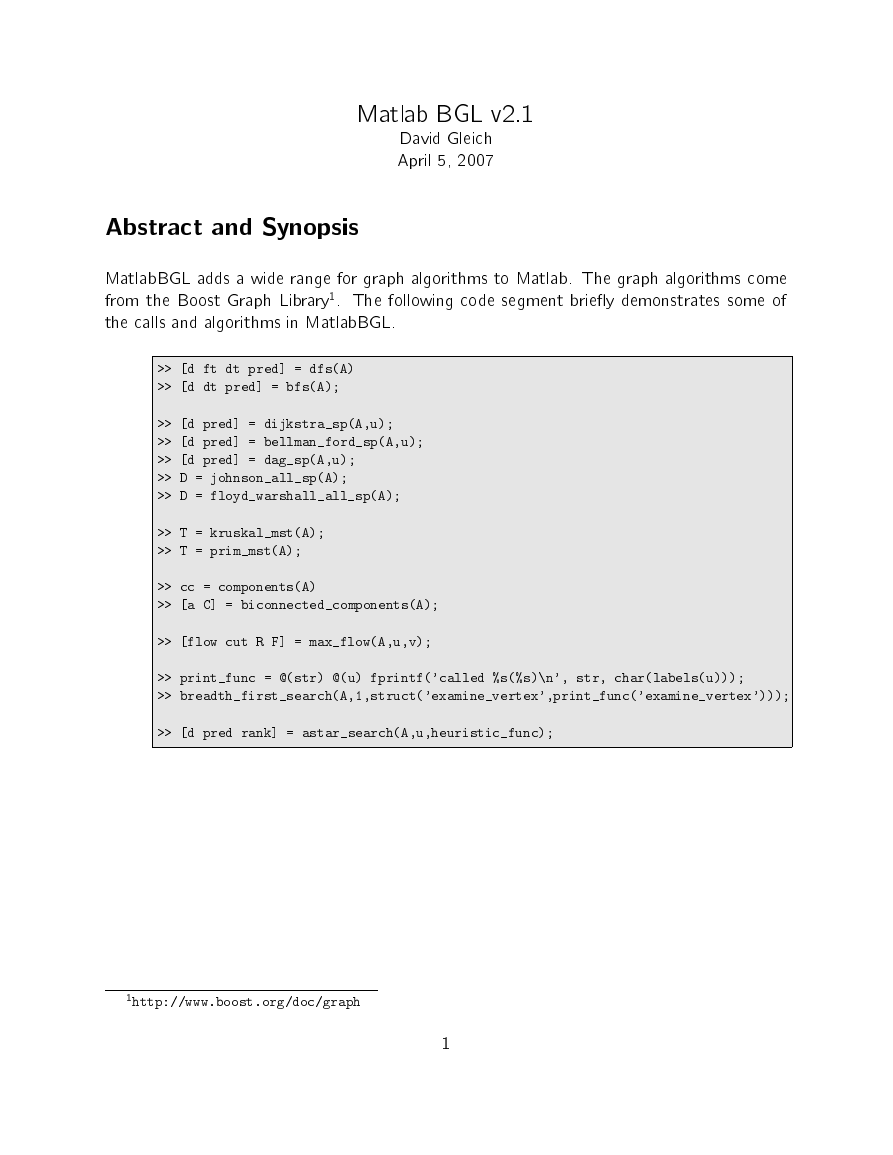
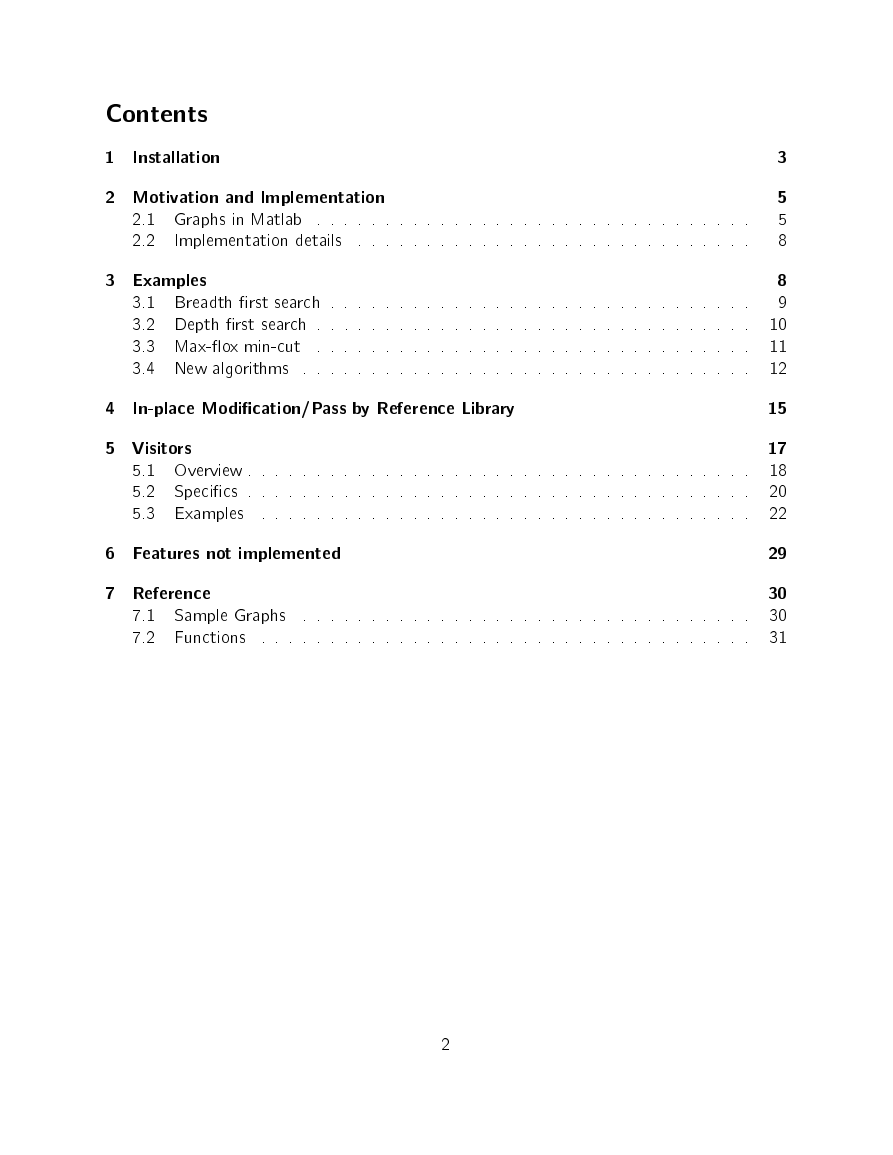
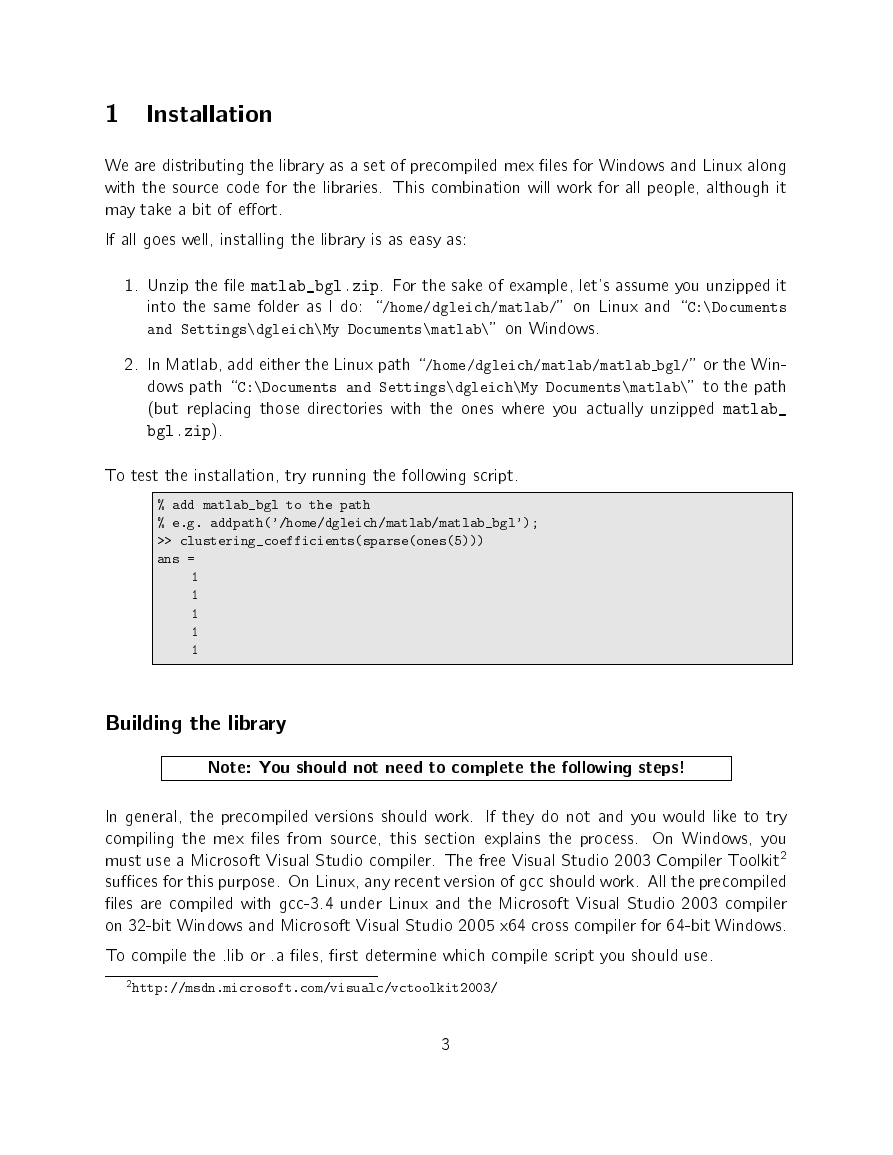

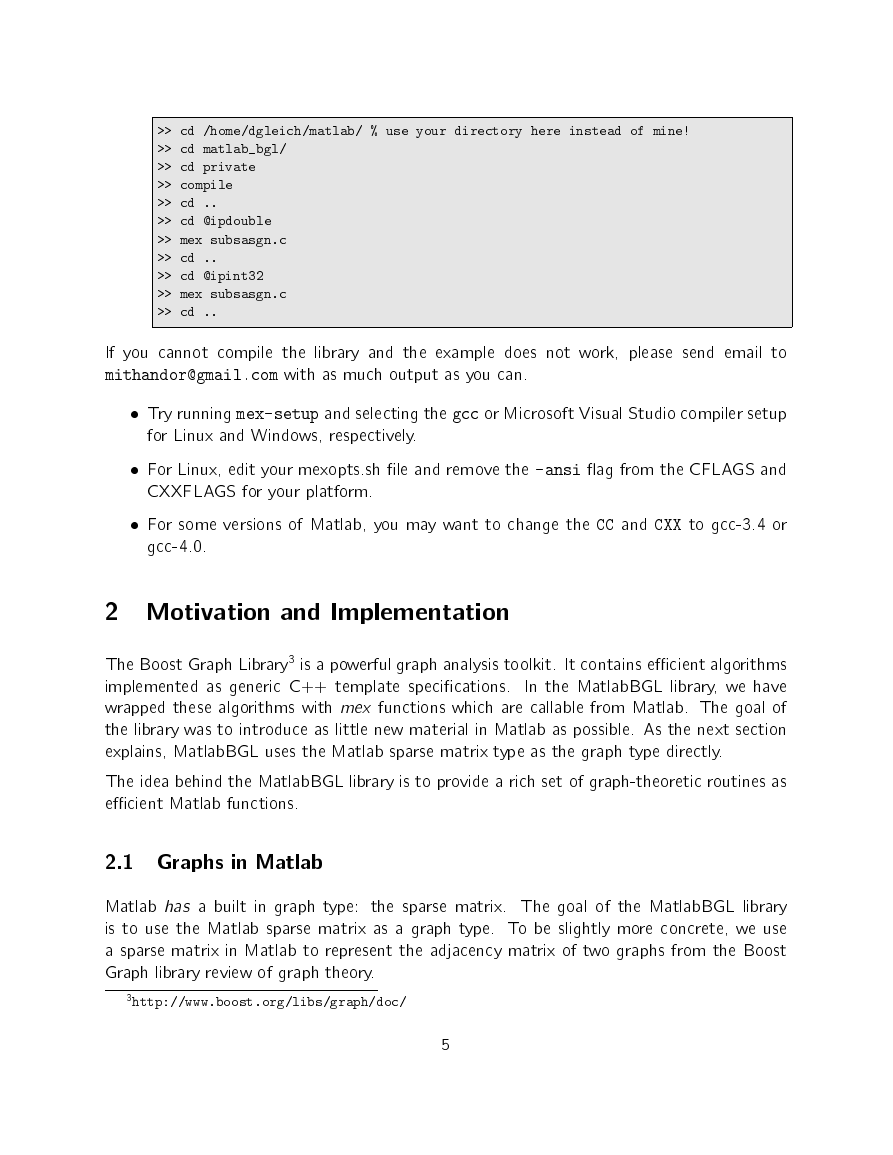

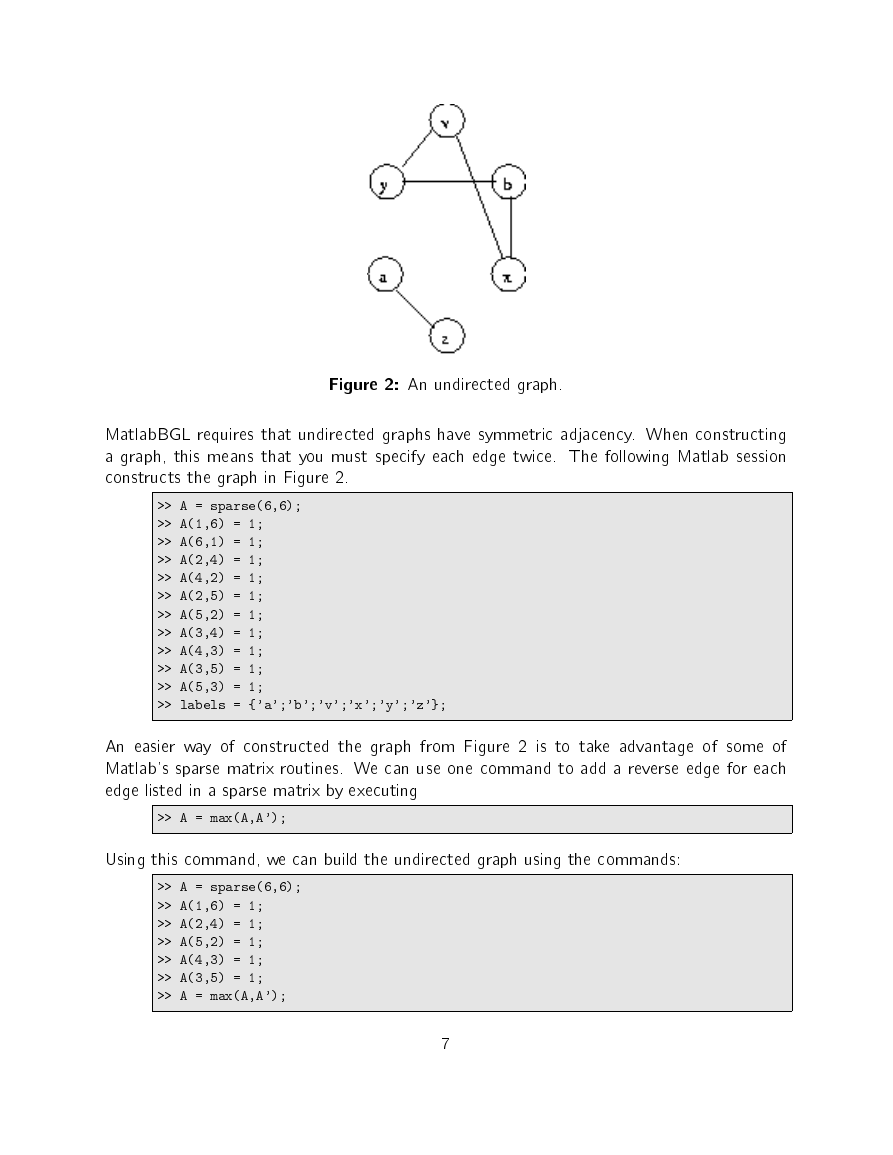
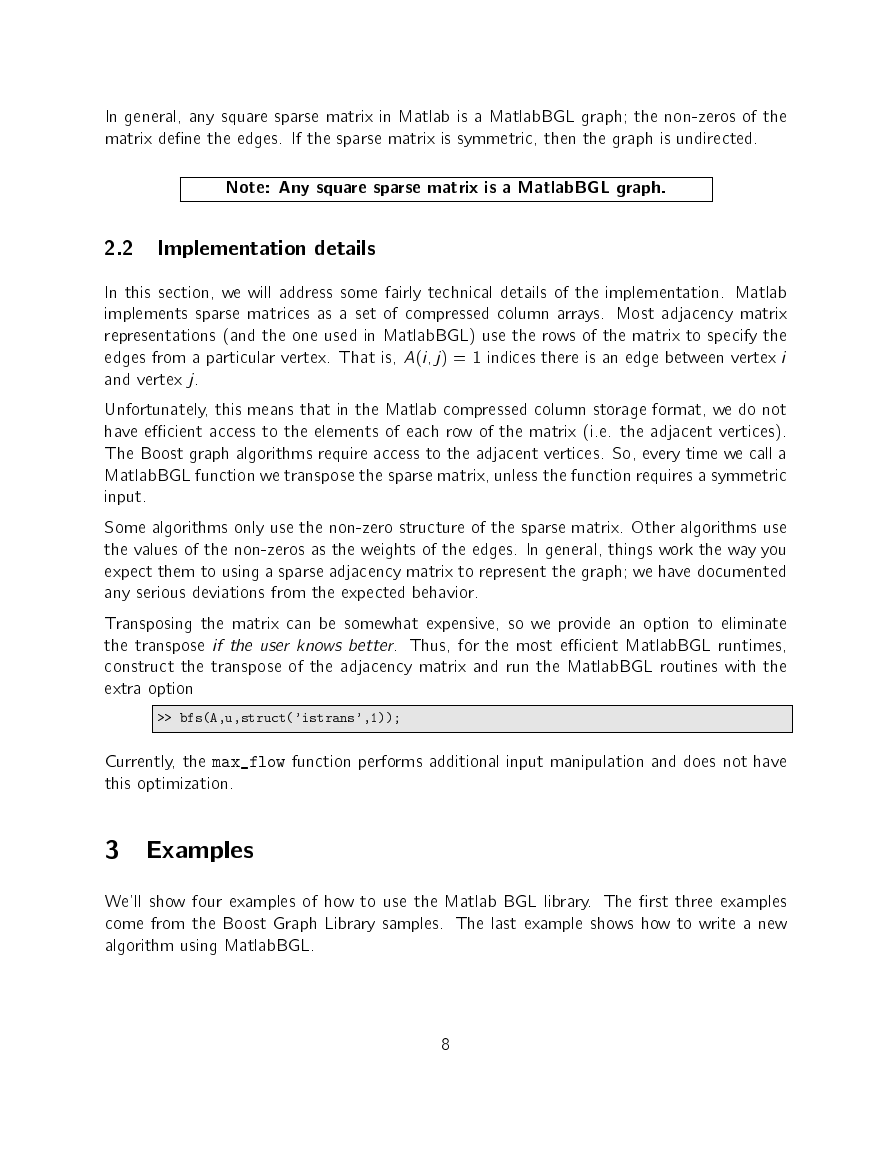








 2023年江西萍乡中考道德与法治真题及答案.doc
2023年江西萍乡中考道德与法治真题及答案.doc 2012年重庆南川中考生物真题及答案.doc
2012年重庆南川中考生物真题及答案.doc 2013年江西师范大学地理学综合及文艺理论基础考研真题.doc
2013年江西师范大学地理学综合及文艺理论基础考研真题.doc 2020年四川甘孜小升初语文真题及答案I卷.doc
2020年四川甘孜小升初语文真题及答案I卷.doc 2020年注册岩土工程师专业基础考试真题及答案.doc
2020年注册岩土工程师专业基础考试真题及答案.doc 2023-2024学年福建省厦门市九年级上学期数学月考试题及答案.doc
2023-2024学年福建省厦门市九年级上学期数学月考试题及答案.doc 2021-2022学年辽宁省沈阳市大东区九年级上学期语文期末试题及答案.doc
2021-2022学年辽宁省沈阳市大东区九年级上学期语文期末试题及答案.doc 2022-2023学年北京东城区初三第一学期物理期末试卷及答案.doc
2022-2023学年北京东城区初三第一学期物理期末试卷及答案.doc 2018上半年江西教师资格初中地理学科知识与教学能力真题及答案.doc
2018上半年江西教师资格初中地理学科知识与教学能力真题及答案.doc 2012年河北国家公务员申论考试真题及答案-省级.doc
2012年河北国家公务员申论考试真题及答案-省级.doc 2020-2021学年江苏省扬州市江都区邵樊片九年级上学期数学第一次质量检测试题及答案.doc
2020-2021学年江苏省扬州市江都区邵樊片九年级上学期数学第一次质量检测试题及答案.doc 2022下半年黑龙江教师资格证中学综合素质真题及答案.doc
2022下半年黑龙江教师资格证中学综合素质真题及答案.doc